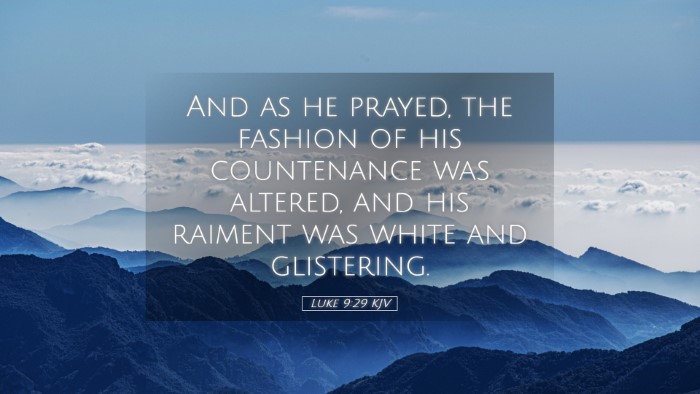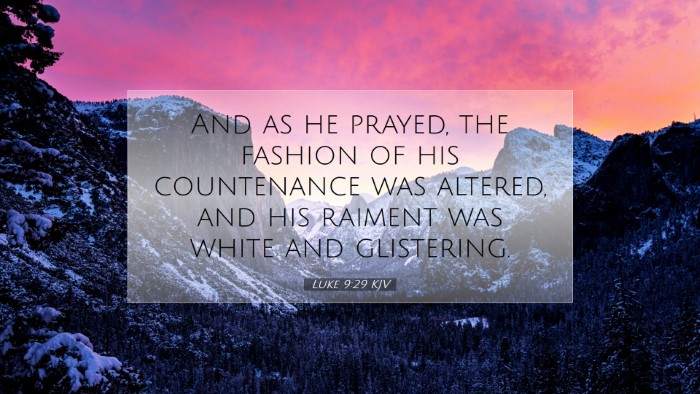Luke 9:29 Commentary
Verse Translation: "And as he prayed, the appearance of his countenance was altered, and his raiment was white and glittering." (Luke 9:29, KJV)
Introduction
The transfiguration of Jesus is a pivotal moment in the Gospel of Luke, illustrating the divine nature of Christ and His identity as the Son of God. In this commentary, we will explore various insights from esteemed public domain commentators, including Matthew Henry, Albert Barnes, and Adam Clarke, to shed light on Luke 9:29.
Context and Background
This event occurs shortly after Jesus predicts His suffering, death, and resurrection. It serves as a confirmation of His divine mission and the glory that awaits Him. The presence of the disciples, particularly Peter, John, and James, indicates the importance of this revelation, preparing them for the events to come.
Analysis of the Verse
The Nature of Prayer
Matthew Henry emphasizes the significance of prayer in this moment. He notes that “as he prayed,” signifies a deep communion with the Father. It is during this intimate moment of prayer that Jesus’ appearance changes, suggesting that prayer is key to experiencing the glory of God.
Transformation and Glory
Albert Barnes comments on the phrase "appearance of his countenance was altered." He explains that this transformation is a physical manifestation of the divine nature of Jesus. This change signifies the revealing of Christ’s true glory, which is typically concealed in His earthly ministry. Barnes notes that "His raiment was white and glittering," symbolizing purity and holiness.
Theological Implications
Adam Clarke adds depth to our understanding of the transfiguration. He points out that this event serves not only to reveal Christ's divine nature but also to foreshadow the glory of the resurrection. Clarke asserts that the dazzling white of Jesus’ garments connects to biblical themes of holiness and the otherness of God’s presence, which can be seen in the descriptions of heavenly beings in the scriptures.
Significance for Discipleship
The transfiguration serves as a moment of revelation for the disciples, reinforcing their understanding of who Jesus truly is. This understanding is essential for their future ministry and witness. The vision of Christ's glory would encourage them during the trials they would face after His crucifixion and resurrection.
- Affirmation of Jesus’ Identity: Recognizing Jesus as more than a teacher or prophet, aligning with the prophetic vision of the Messiah.
- Preparation for Suffering: The experience of witnessing His glory would strengthen the disciples’ faith when facing persecution.
- Call to Holiness: Observing Jesus in His glory reminds disciples of the holiness they are called to pursue as followers of Christ.
Applications for Today
For pastors, students, theologians, and Bible scholars, the transfiguration of Jesus in Luke 9:29 invites us to consider several applications:
- The Power of Prayer: Emphasizing the importance of prayer in seeking God’s presence and experiencing transformation.
- Recognition of Christ’s Glory: Encouraging a deeper understanding and appreciation of Christ’s divine nature and the implications for our faith.
- Embracing Suffering: Understanding that trials may have a purpose in cultivating a deeper faith, just as the disciples were prepared for the cross.
Conclusion
Luke 9:29 encapsulates a critical moment of revelation in the life of Christ, showcasing His divine nature and preparing His disciples for the future. Through the combined insights of Matthew Henry, Albert Barnes, and Adam Clarke, we glean a deeper understanding of the significance of prayer, transformation, and the implications for both the disciples and believers today. This passage encourages us not only to recognize Christ’s glory but also to reflect that glory in our own lives as we follow Him.


